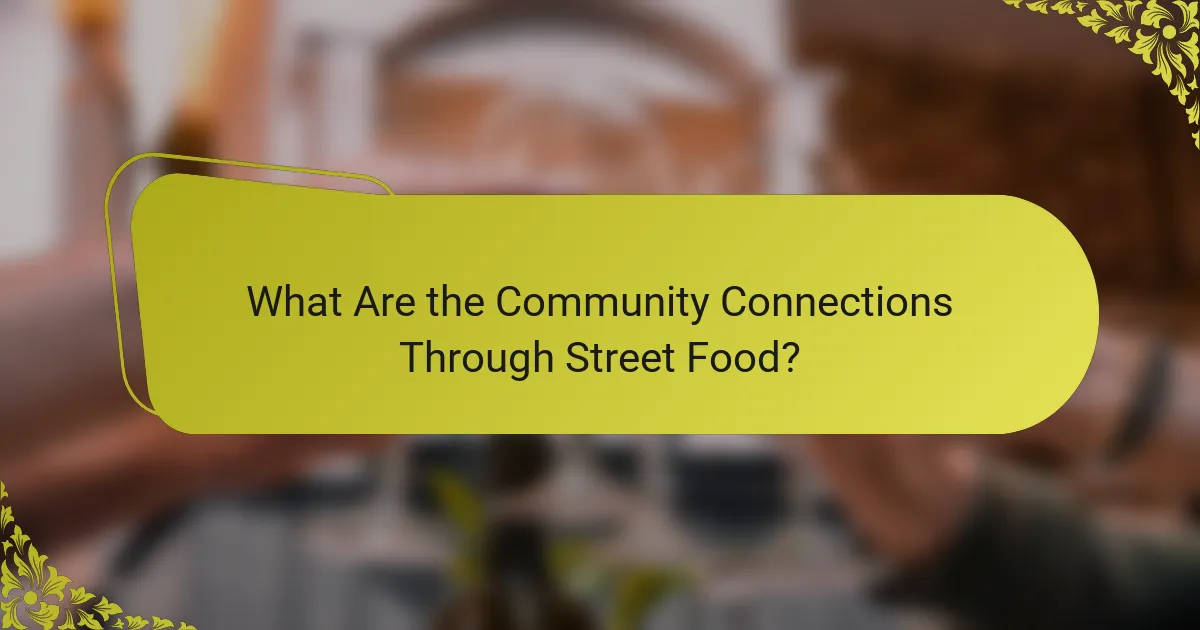Street food is a vibrant expression of local culture, showcasing unique flavors and traditions that connect communities to their culinary heritage. It fosters social connections through shared experiences, creating an atmosphere of cultural appreciation and celebration. By preserving traditional cooking methods and recipes, street food serves as a living testament to a community’s identity and history.

How Does Street Food Celebrate Local Culture?
Street food is a vibrant expression of local culture, showcasing the unique flavors and traditions of a community. It serves as a culinary bridge, connecting people to their heritage through accessible and often affordable dishes.
Showcases regional ingredients
Street food highlights the use of local ingredients, often sourced from nearby farms or markets. This not only supports local economies but also ensures that the dishes reflect the seasonal availability of produce, meats, and spices.
For example, in Mexico, street vendors may use fresh corn to make tortillas, while in Italy, you might find vendors selling arancini made with locally sourced rice and cheeses. Such practices keep the culinary traditions alive and relevant.
Reflects traditional cooking methods
Many street food vendors employ traditional cooking techniques passed down through generations. These methods can include grilling, frying, or steaming, often using equipment that has historical significance.
In Thailand, for instance, street food stalls often use woks over open flames, creating dishes that are not only flavorful but also steeped in cultural practices. This connection to heritage enhances the authenticity of the food experience.
Promotes local festivals
Street food plays a crucial role in local festivals, where it becomes a centerpiece of celebration and community gathering. These events often feature a variety of vendors showcasing regional specialties, drawing both locals and tourists.
During the annual Oktoberfest in Germany, for example, street food stalls serve traditional bratwurst and pretzels, allowing attendees to indulge in local flavors while celebrating cultural heritage. This fosters a sense of community and pride among residents.

What Are the Community Connections Through Street Food?
Street food serves as a vital link within communities, fostering connections among people through shared culinary experiences. It brings together diverse groups, creating a vibrant atmosphere that promotes socialization and cultural appreciation.
Encourages social interactions
Street food acts as a communal hub where individuals gather to enjoy meals together, facilitating conversations and friendships. Food stalls and markets often become meeting points, allowing people from different backgrounds to connect over shared tastes.
Events centered around street food, such as festivals or night markets, enhance these interactions by offering a variety of dishes, encouraging patrons to try new foods and engage with vendors. This creates an inclusive environment that nurtures community bonds.
Supports local economies
Street food vendors contribute significantly to local economies by providing affordable dining options and creating jobs. Many vendors source ingredients from nearby farmers and suppliers, ensuring that money circulates within the community.
By attracting both locals and tourists, street food can boost foot traffic in neighborhoods, benefiting surrounding businesses. Supporting street food can lead to a thriving local economy, particularly in urban areas where small businesses often struggle.
Fosters cultural exchange
Street food is a reflection of a region’s culinary heritage, showcasing traditional recipes and cooking methods. This diversity allows for cultural exchange, as people experience flavors and dishes from different backgrounds.
Food festivals and cultural events often highlight street food from various ethnic communities, providing opportunities for education and appreciation of different cultures. This exchange enriches the community, promoting understanding and respect among its members.

How Does Street Food Preserve Culinary Heritage?
Street food plays a crucial role in preserving culinary heritage by maintaining traditional cooking methods and recipes that have been passed down through generations. It serves as a living testament to cultural identity, allowing communities to celebrate their unique flavors and food practices.
Maintains traditional recipes
Street food vendors often rely on age-old recipes that reflect the culinary traditions of their region. These recipes are typically simple, using locally sourced ingredients that highlight the flavors of the area. For example, a traditional taco stand in Mexico may use family recipes that have been refined over decades, ensuring the authenticity of the dish.
By serving these classic dishes, street food helps keep these culinary traditions alive, allowing younger generations to learn and appreciate their heritage. This continuity fosters a sense of pride and connection to cultural roots.
Involves family-owned businesses
Many street food vendors are family-owned businesses, which strengthens community ties and supports local economies. These establishments often operate on a small scale, allowing families to pass down their culinary skills and knowledge to the next generation. This familial involvement ensures that the recipes and cooking techniques remain authentic and true to their origins.
Supporting these businesses not only preserves culinary heritage but also promotes local entrepreneurship. Consumers can enjoy unique flavors while contributing to the sustainability of their community’s food culture.
Highlights historical significance
Street food often reflects the historical and cultural narratives of a region, showcasing how food has evolved over time. Dishes may have origins linked to historical events, trade routes, or migrations, making them significant beyond just their taste. For instance, the popularity of certain street foods can be traced back to historical influences, such as the introduction of spices from trade.
By enjoying street food, individuals engage with the history of their community, gaining insights into the cultural exchanges that shaped their culinary landscape. This connection to history enriches the dining experience and fosters a deeper appreciation for local food traditions.
![What Are Popular Street Food Dishes in [Region]?](/wp-content/uploads/what-are-popular-street-food-dishes-in-region-4.webp)
What Are Popular Street Food Dishes in [Region]?
Street food is a vibrant part of local culture, showcasing unique flavors and culinary traditions. Popular street food dishes often reflect regional ingredients, cooking methods, and community connections.
Tacos in Mexico
Tacos are a quintessential street food in Mexico, known for their versatility and rich flavors. Typically made with corn tortillas, they can be filled with a variety of ingredients, including grilled meats, beans, cheese, and fresh vegetables.
When enjoying tacos, consider trying different types such as tacos al pastor, which feature marinated pork, or fish tacos, popular in coastal areas. Street vendors often serve them with an array of salsas and toppings, allowing for a personalized experience.
Pad Thai in Thailand
Pad Thai is a beloved street food dish in Thailand, recognized for its balance of sweet, sour, and savory flavors. This stir-fried noodle dish typically includes rice noodles, shrimp or chicken, eggs, and a mix of vegetables, all tossed in a tamarind-based sauce.
When ordering Pad Thai from street vendors, you can often customize it with additional toppings like crushed peanuts, lime, and fresh herbs. It’s a quick and satisfying meal, usually served in a matter of minutes.
Currywurst in Germany
Currywurst is a popular street food in Germany, especially in Berlin, where it originated. This dish consists of steamed and fried pork sausage, sliced and served with a tangy curry ketchup and often accompanied by fries.
For an authentic experience, look for vendors that prepare their own curry sauce, which can vary in spice levels. Currywurst is typically enjoyed as a quick snack or meal on the go, making it a staple of German street food culture.

How to Choose the Best Street Food Vendors?
Selecting the best street food vendors involves assessing their popularity, food safety practices, and menu variety. These factors not only enhance your culinary experience but also ensure you enjoy safe and diverse options.
Check for local popularity
Local popularity is a strong indicator of a vendor’s quality and taste. Look for long lines of customers, as this often signifies that the food is both delicious and well-regarded in the community.
Additionally, consider asking locals for recommendations. They can point you to hidden gems that might not be immediately visible to tourists.
Look for food safety practices
Food safety is crucial when choosing street food vendors. Observe the cleanliness of the vendor’s cart or stall, as well as the hygiene practices of the staff. Vendors who wear gloves and maintain a tidy workspace are generally more reliable.
Check for any visible signs of food spoilage or improper storage. If the vendor is using fresh ingredients and cooking food at the right temperatures, it’s a good sign of their commitment to safety.
Assess menu variety
A diverse menu can indicate a vendor’s culinary expertise and willingness to cater to different tastes. Look for vendors that offer a range of options, including vegetarian or gluten-free dishes, which can enhance your overall experience.
However, be cautious of vendors with overly extensive menus, as this might suggest that they are not focusing on quality. A well-curated selection of items often reflects a vendor’s specialty and passion for their craft.
